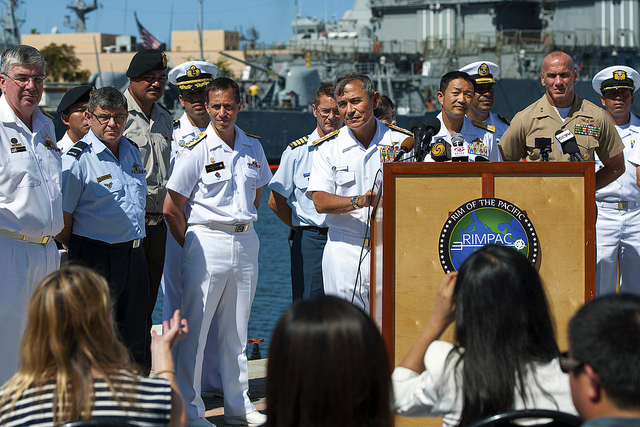
Adm. Harry Harris, commander of U.S. Pacific Fleet, takes a question from a reporter during a press conference announcing the beginning of exercise Rim of the Pacific (RIMPAC) 2014. Philstar.com/U.S. Navy/MC2 Diana Quinlan
PEARL HARBOR, Hawaii — The commander of the U.S. Pacific Fleet said Monday that China's first-time participation in the world's largest maritime exercises in Hawaii will help Beijing and other nations work together in a crisis.
The Rim of the Pacific drills will help countries respond as they did when Typhoon Haiyan hit the Philippines last year and when Malaysia Airlines Flight 370 disappeared in March, Adm. Harry Harris told reporters at a news conference opening a month of training.
"These are multilateral events. Real world operations. It helps us if we practice together in settings like this," Harris said.
The U.S. hopes the exercises will help the U.S. and China increase transparency and better understand each other, he said.
China is embroiled in territorial disputes with several countries participating in the exercises, including Japan and the Philippines. Both countries are U.S. allies.
Many of the disputes are over waters in the South China Sea. China, the Philippines, Brunei, Malaysia, Taiwan and Vietnam have overlapping claims in potentially oil- and gas-rich areas there. Beijing claims virtually the entire body of water.
Japan and China both claim a group of uninhabited islands in the East China Sea called Senkaku in Japanese and Diaoyu in Chinese.
There has been tension between China and the U.S. itself.
China views U.S. moves to "pivot" or rebalance toward Asia and the Pacific as an effort to counter Beijing's expanding military and contain its growing economic and political influence. The U.S. says it's shifting attention to the region because of its growing economic importance.
Harris said the presence of the countries makes a statement that they believe they must improve cooperation despite disagreements. He said "increasing risks" in the region are capable of disrupting stability and affecting "our collective prosperity."
Countries "can agree to disagree without being disagreeable," Harris said.
China sent military observers to watch the drills in 1998, but it has never sent ships before.
This year, China sent four ships, two helicopters, a commando unit and a diving team along with 1,100 Chinese officers and sailors.
One of the ships is a hospital ship, the Peace Ark. A Chinese oiler, frigate and destroyer are expected to join a maritime interdiction operations task force.
The U.S. Navy is hosting about 25,000 military personnel from 22 countries at the exercises. The U.S. Pacific Fleet holds the drills every two years.
Japanese Rear Adm. Yasuki Nakahata, the vice commander of the exercises, said his country is happy China is at the drills.
"It is a very good thing for a country as large as China to acquire new equipment and contribute to a more stable security situation in nearby waters," Nakahata said. "We greatly welcome this and are hopeful."
After the first six questions at the news conference were all related to China, Harris interrupted the queries for a moment to stress the drills were about much more than China.
He pointed out the Southeast Asian nation of Brunei was also participating for the first time.
"This is not about China and the United States. This is about 22 nations that are trying to work together for multilateral operability and transparency," Harris said.
http://www.philstar.com/world/2014/07/01/1341219/us-admiral-drills-help-china-us-work-together

No comments:
Post a Comment
Note: Only a member of this blog may post a comment.